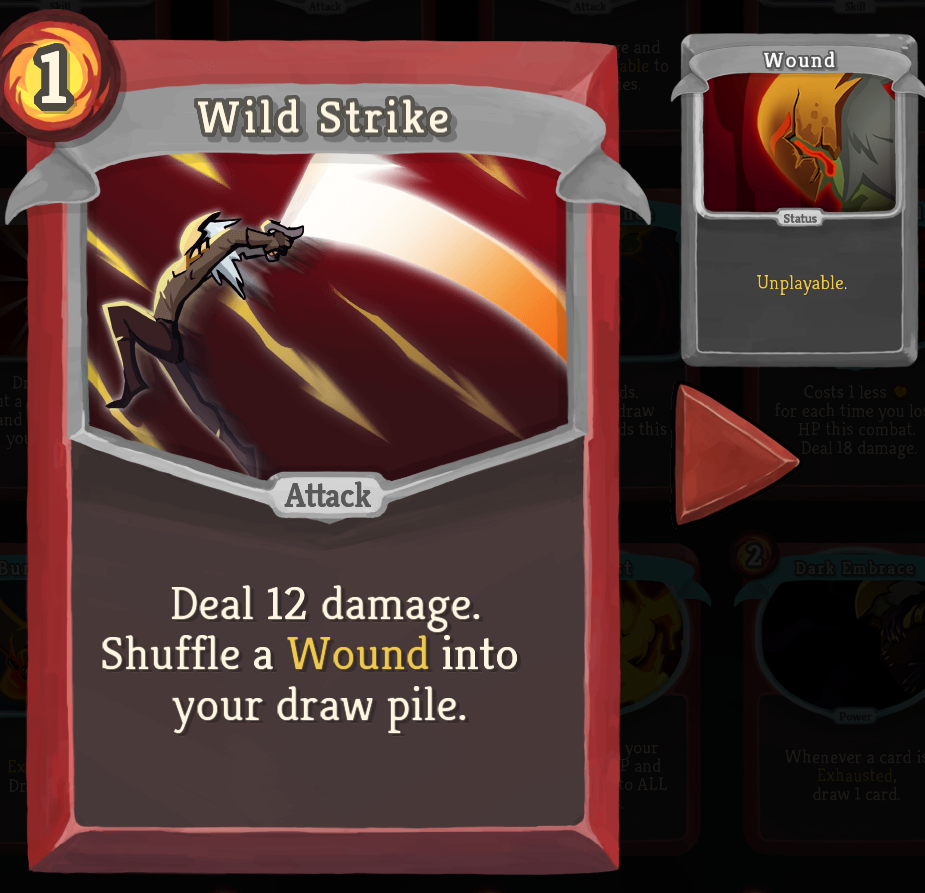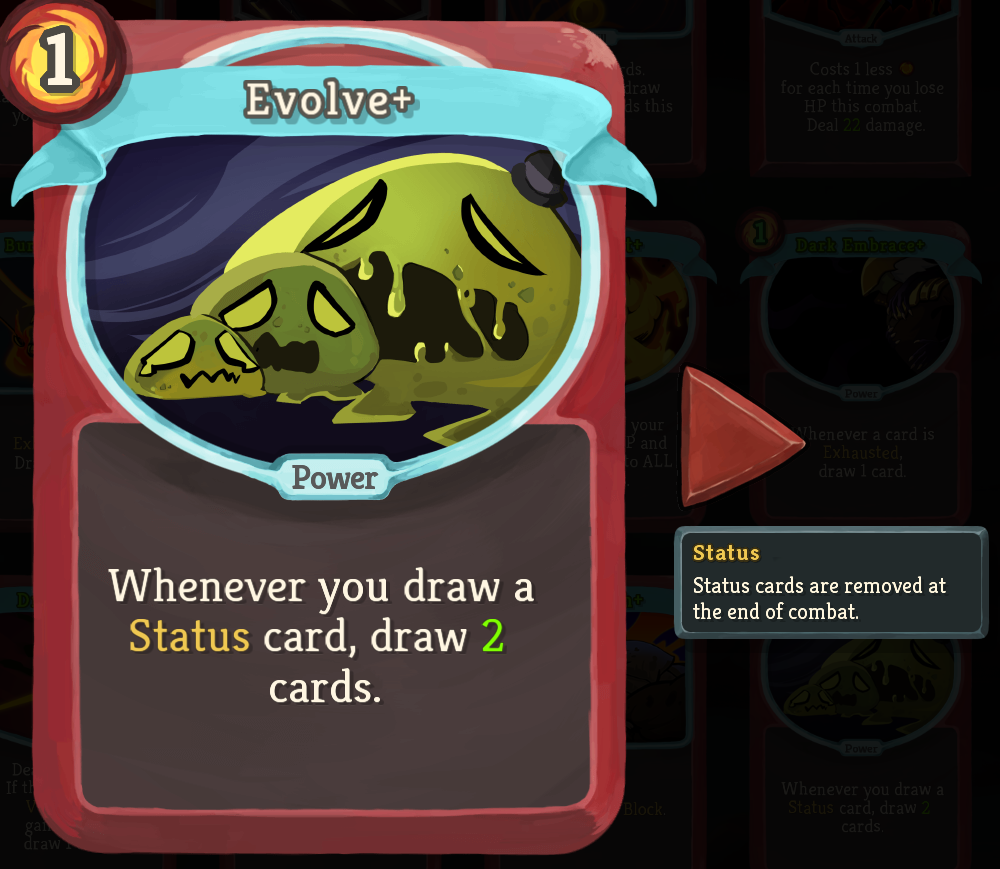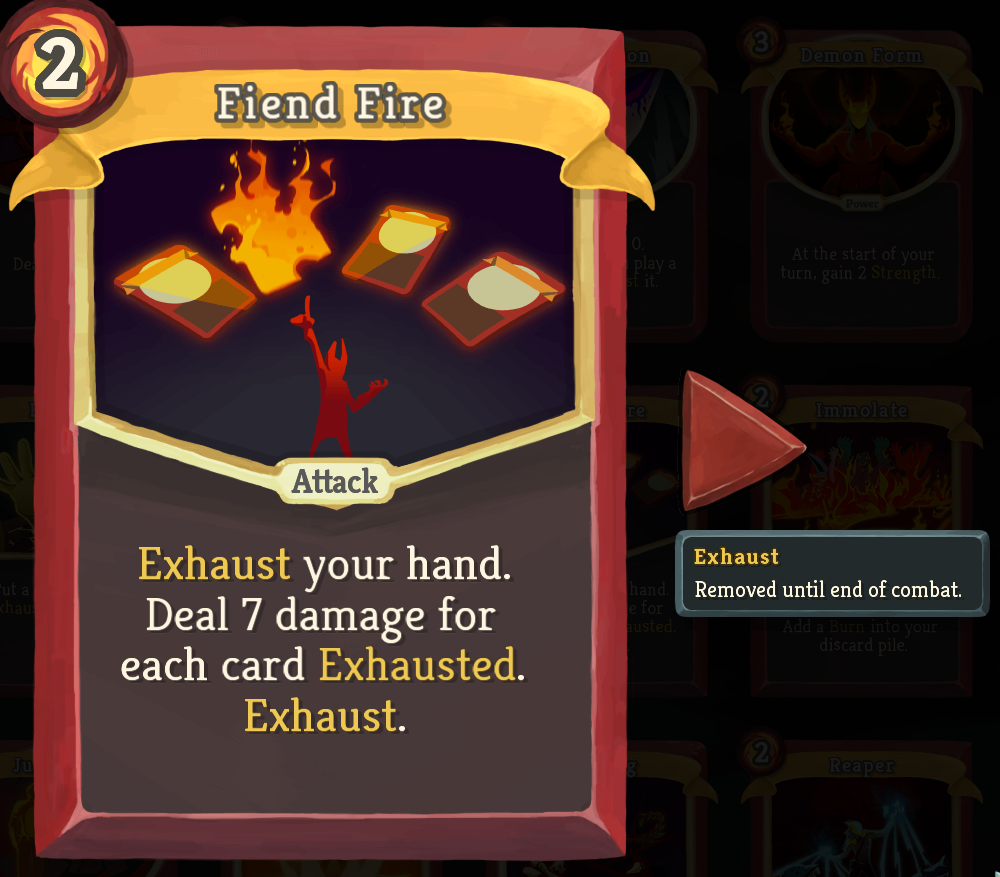At Cloudfall Studios, we have a channel for “presenting” design theories that we’ve been learning or practicing. This one is based on Slay the Spire: you should play it!
Presenting:
“What Goes Through My Head When Playing
Slay the Spire”
AC: I’m trying to figure out Slay the Spire’s card design and I think I have an idea. cheque it out
AC: Specifically ive been thinking about how jorbs frames fights, but i want to think about it from a designer perspective. first of all, enemies present two base problems:
They have health. Reduce it to zero to win
They damage you, and if you take too much over time, you lose.
[health persists across fights. this means players can choose to lose health on Elite enemies or events now, in order to get strong relics and save health later.]
AC: and complicating factors are:
some enemies get STRONGER as the fight goes, meaning there are frequent situations where you must choose whether to spend your limited energy on attacks or blocks.
Often, you must willingly take damage, spending energy to attack instead. That can overall save you more health because you end the fight soonerSometimes there are MANY enemies. If one enemy gets stronger over time but has more health than the second enemy, who do you prioritize with your attack?
AC: Players have 2 x 2 + 1 + 1 solutions.
Frontloaded damage cards turn your energy into pain. they do… what they say.
I guess to be fair they tend to have some bonus effects on them. Usually they’re really strong but present a downside. Sometimes they’re strong but you can only use em once.
I like Carnage poetically. the fact that you have to give into your aggressive urge in order to deal dmg. & if you ever let the urge pass, it won’t come back.
Scaling damage cards turn your energy into less damage upfront, but more and more dmg over time. I think they’re a trap for intermediate players, because they see the potential and forget that you could have spent your energy dealing 10 damage. instead, players often deal 1+2+3+4 damage across like 5 turns of getting smacked.
I think scaling damage can be in the form of a passive ability that makes your other cards better, or an active ability that contextually gets better with preparation.
Noting: It doesn't have to be an exponential curve. Sometimes just giving a +1 boost to all your other cards for 1 energy is technically scaling.
pop quiz: frontloaded or scaling?
Frontloaded block cards... block. They block the amount they say. I noticed that often block cards do it in a variety of cute ways like “block whenever you play an attack” or “reduce your enemy’s attack” instead of just “block”.
Scaling block cards improve your block as the fight goes on. Things like Footwork or Feel No Pain. I think specifically, it’s “scaling” if instead of directly offering you a large amount of upfront block, it indefinitely increases block without needing to spend that energy/card again.
AC: Secondlast solution: card selection lets you get to the specific card you need on any given specific turn. This can help you lean on a handful of really niche-powerful cards instead of a bunch of lukewarm consistent cards.
AC: last solution: utility cards that kinda give scaling, but in more meta ways? it seems like most cards present or solve a “meta” problem. For example, 0-cost cards are usually balanced to be worse than 1-cost cards. But if you have something that turns energy to card draw, then you can play like 7 no-cost cards instead of 3 one-cost cards.
AC: im oversimplifying but you get the idea. some cards do nothing but manipulate secondary stats like energy, card selection, and all the other stats that surround - but don’t substitute for -your actual ability to do what matters. (dealing pain & staying alive.)
note: don’t actually build this
AC: If we extrapolate these lessons, we can see one potential formula to design a game system:
Present more than one need, and some mutual exclusivity that prevents you from doing it all at once. There must be compromise somewhere. In StS, you have limited energy and card draw. You need to choose between ending the fight sooner but taking immediate damage, or prolonging the fight and maybe taking more damage if you get a bad draw or they get stronger.
Present complicating factors that make the answer harder to learn. For StS, it's the fact that some enemies scale up, or slow you down by trashing your deck / debuffing you. It's not always apparent if you scale faster than your enemy or not.
Present solutions that could solve one base problem, but never directly or fully. It must:
Partially solve a complicating factor [it's an aoe card! or, it gets stronger each time!]
Is stronger than average, at a cost [lots of damage, but puts a wound in your deck].
Is slightly weaker than average, but provides a potential bonus [deals more damage if you played lost of frost cards this combat]
4. …finally, add solutions that tie together any shared mechanics. reward players for choosing particular synergies.
For example, Ironclad’s Wild Strike offers extra damage, but puts a Wound in your deck (a useless card that essentially wastes one of your draws).
However, Ironclad also has Evolve, which lets you draw through Status cards - It partially negates some of the downside to Wild Strike!
Finally, if you have a card like Fiend Fire, you have an engine at this point. Get lots of status cards in your deck from Wild Strike, fill your hands with more cards than usual [thanks to Evolve], then use Fiend Fire for massive damage!



In this sense, Slay the Spire characters have several mechanics that "pivot" on one another. They’re incidental in some cases (Wild Strike is servicable even if you don’t have Evolve) but you can lean into them if you want.
AC: You can make individual cards more important in exchange for the variability of drawing cards in a bad order, or sacrificing frontloaded damage in order to scale better. For example, Evolve as a card doesn’t help you win when you first play it, but it’s useful in like 3 turns from now. It’s up to you to figure out if your deck needs help in long fights or short fights!
AC: As game designers, we can probably make players have fun by forcing them to choose between short-term gain and long-term gain in this fashion. I have a feeling we’re “supposed” to design cards that only ever solve some of the problems. If any choice is obviously the best regardless of what your past or future is, then I think we’ve failed as designers.
AC: Slay the Spire solutions either introduce new problems, or are otherwise definitely only useful in a portion of the situations you’ll find yourself in.
AC: Anyway, here’s my first card choice of the session. [yeah havent picked my card yet.]
Poisoned Stab deals a fine amount of damage, but the poison mechanic can be the key to killing BOSSES… I’d just need to find 1-2 more poison cards.
It can't do this big long-term goal on its own - but it does open the door to solving the “how the heck do I kill a boss” problem if I can just keep an eye out for a few more poison cards.
Dagger Throw deals similar damage to Poisoned Stab. 6+3 isn’t the same as 9, but it’s close enough before Ascension 20.
Drawing and discarding a card smooths out my draws, letting me dig towards better selection.
This might be really useful right now, since most of my starting deck is bad. I’d rather filter my draws towards the few good cards in my deck if I can.
Additionally, sometimes discarding a card is beneficial for other mechanics. Maybe I can let myself get cursed more often, since I can discard them? [probably not.]
Finisher is the worst card out of these and has a low floor. However, it has the potential to deal ridiculous damage if I lean into building my entire deck in a very particular way.
That is to say: if I choose this card, I must dedicate myself towards building my deck out with a bunch of low-cost attacks to maximize this card.
AC: I want to pick Finisher because it's an uncommon card, meaning if I miss this opportunity I might not get another one. And it’s fun. But I’d rather not lose against Gremlin Nob.
interesting case of ‘fake’ synergy: Bane is often difficult to include in poison-heavy decks., even though at first it looks perfect.
Ultimately, I choose poison stab because I think the future synergies with poison are easier, and I don't want to dedicate myself into a narrow strategy off the bat. If I already had a bunch of cheap attacks, Finisher would be better.
(Postmortem: I should have chosen Dagger Throw.)
AC: Forgot to take a picture of the next few card choices because they were ‘obvious’. But noting that because I needed redundancy in damage cards, it meant that I picked a handful of things that don't have perfect synergies.
AC: As it stands, my card pool includes two poison cards and two cards that are rapid attacks. Reverse-engineering this design means that player needs require more than exactly one card [acquisition point] to fully solve certain problems.
I had to look for redundancy across different cards just because I only pick from 1 of 3 cards per fight.
Finding a shared redundancy [dealing damage] across different cards now means something cool: if I find a synergy card, it won't be a perfect fit! I’ve been wrestling that concept in design for forever!
AC: Like. I might find a card that synergizes with half my picks but not the other. and now I have to figure out what synergy is currently better [and what is projected to be better].
Additionally, having these 'random' but slightly shared mechanics means that you can construct synergies kind of on the fly. but it's not guaranteed that the synergies have to always match exactly card-to-card, if that makes sense
AC: An important part of card selection is being able to readily perceive future problems. In Slay the Spire [probably not important for all games, but still] there are very obvious threats that have obvious ideal solutions. For example, I'm very likely to enter a fight against Gremblin Nob.
That’s a guy I gotta kill REALLY fast, and without using skills.
Art by ambient.color on Instagram
AC: For context, Gremlin Nob deals a ton of damage to you, and he gets stronger when you use skills (whether to block or deal damage). Generally this means you’re in an all-out slugfest, launching every attack you have, almost no blocking.
Because I’m scared of the chance of fighting Gremlin Nob, I really value attack cards more right now. This is especially true since I got “greedy” and took a great block card last floor… that’ll be useful in like, 12 fights from now.
I definitely need more attacks in my deck in order to ensure I can actually kill this meatwall before he kills me.
AC: ...But life isn’t that simple, because the final boss of this area has a “defensive” phase where I'm punished for playing too many attacks.
So I have to navigate the tension of short-term attack priority, but longer-term block priority. But in this sense, I'm not just picking cards for synergies alone - I'm also driven to pick cards that suit the problems coming up ahead. More importantly for us, the game presents problems that make it obvious what you need to do to succeed!
Now it’s just a matter of doing it!
AC: LOL
AC: i DIED against gremlin nob because I couldn't deal enough damage in time. That Footwork… I regret taking it. I got too greedy taking these uncommon scaling cards instead of leaning more into attacks. and I paid the price!
AC: Anyway some key takeaways from designing games that involve lots of customization
Art by ambient.color on Instagram
Provide more than one problem, or more than one aspirational goal.
The solutions you offer can’t directly solve the goal. They need smth like:
A long-term downside.
Weaker numbers now, but better later.
Imperfect numbers in this particular area, but also partially solves something else.
Building synergies isn’t just about “get a bonus for having both”. At least one half of a synergy pair needs to work fine on its own. The other half has to, as part of its own existence, shift the puzzle itself. IE it can’t just be stronger, it has to offer something like “long-term strength at the cost of energy or card draw this turn”.
In other games we have to make sure to “artifically” introduce some kind of sacrifice akin to “energy and card draw” to make scaling cards not an autoplay decision.The core of games is maybe “accept some loss now for later gain in some category” vs “gain or preserve something now, but take greater losses in some category later”.
present OBVIOUS problems. don’t be shy. let players prepare for SOMETHING, have SOME kind of guidance instead of running a calculator in the mist.
Gremlin nob is terrifying, but is also INTEGRAL to the Slay the Spire experience. It sets the tone for the entire game [forcing you to be less picky about attacks early, meaning afterwards you have to adapt to whatever cards you rush-picked early on. it forces you to prioritize defense cards in act 2 to make up for all the attacks you drafted early on… etc)
AC: Maybe every game could use a gremlin nob. Is that the robber in catan? Is that prospero in Captain’s Gambit?
AC: the answer is yes










